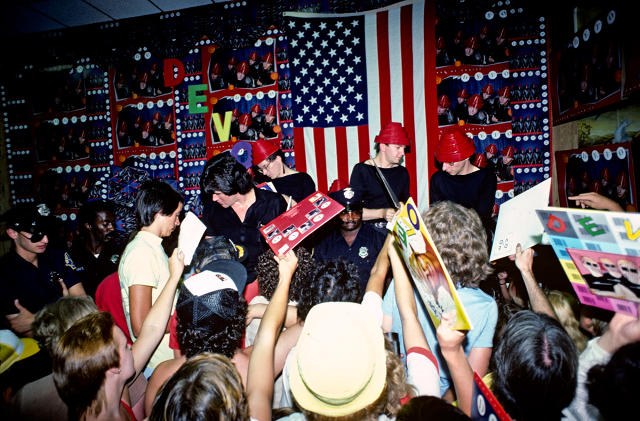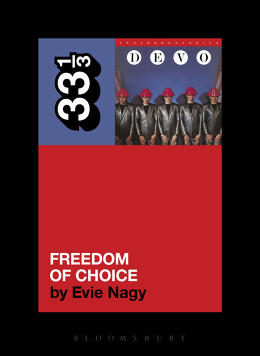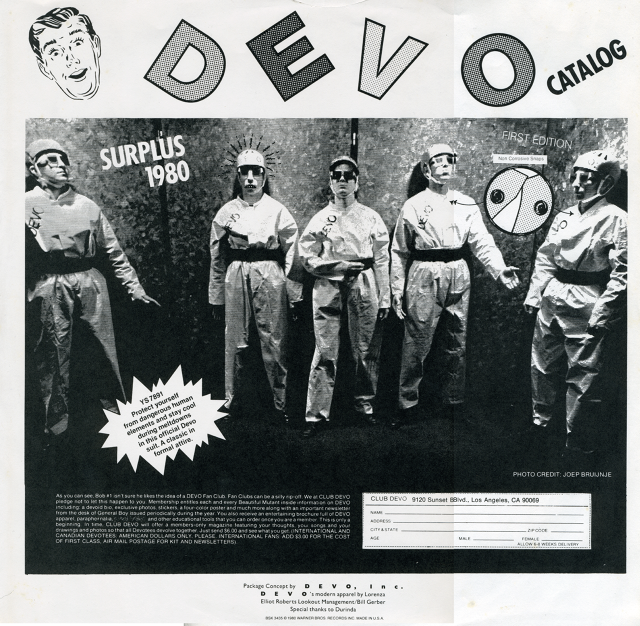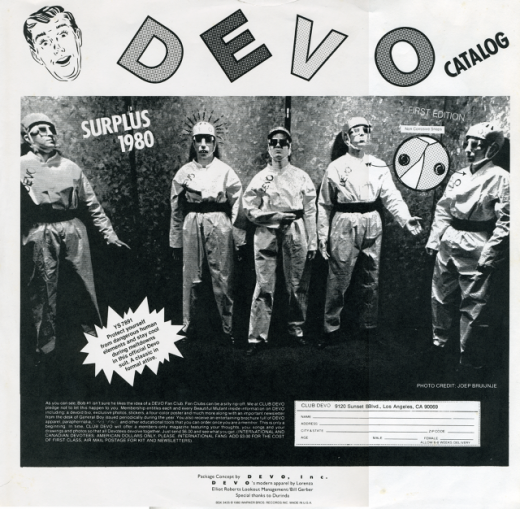How Rock Iconoclasts Devo Became Leaders Of The 1980s Nerd Nirvana
In an excerpt from her new book, Evie Nagy describes how the new wave pioneers fought corporate control with Freedom of Choice.
Ohio art rockers Devo, cofounded by Mark Mothersbaugh and Gerald Casale, gained national acclaim with their 1978 album debut Q: Are We Not Men? A: We Are Devo! But it was their third album, 1980’s Freedom of Choice, that broke them into the mainstream, thanks to a perfect union of pop sensibility and subversive appeal. Songs like “Whip It” and “Freedom of Choice” weren’t just MTV hits—they advanced Devo’s theory of de-evolution, which was that people would regress to conformist automatons, and corporate and literal machinery would consume free will. At the same time, they confronted capitalism by embracing it, maintaining as much creative and financial control as they could in a major label system, and building an undeniably strong, unique brand. This excerpt of staff writer Evie Nagy‘s book about Freedom of Choice, out today as part of Bloomsbury’s 33 1/3 series on important albums (with a foreword by Portlandia’s Fred Armisen), describes how Devo spoofed commerce for profit, and found an audience of outsiders that set them apart from equally theatrical—and commercially minded—contemporaries like Kiss.
If, in the coming battle with mechanical corporate authoritarianism, humanity was both a weakness and a strength, Devo were going to leverage as much of that self-determination as they could in controlling their creative enterprise, even after signing to Warners. From incorporating in 1977, to insisting on control over their videos, artwork, merchandise, and stage shows, to ultimately rejecting external producers, Devo never lost sight of what they were and weren’t willing to compromise.
This is, curiously, not among the reasons that Devo in the late ’70s and early ’80s were repeatedly compared to, of all bands, Kiss. Gene Simmons’s tenacious control of his band’s property, from Kiss’s trademarked faces to a staggeringly broad merchandizing empire, was much more aggressively in service of amassing personal wealth than Devo’s; but they shared a core philosophy of creating a singular creative identity and legally owning as much of it as possible in a label system.

But it was the presentation, not the business model, that prompted the media and even Devo themselves to discuss the two bands in the same breath. In the New York Times in 1979, John Rockwell gave Duty Now for the Future and Kiss’s Dynasty a joint review as two new discs from “highly theatrical concept rock groups.”
“Devo has smarts and, so far, no overwhelming commercial success. Kiss has dumbs and lots of commercial success.” Rockwell wrote that Dynasty proved that “success in rock, especially in the young teen market, is only marginally related to music,” and lamented that Duty Now for the Future wasn’t likely to change Devo’s status unless “Devo gets lucky and has a novelty hit.”

“Someone once said, derisively, that we were a ‘thinking man’s Kiss,’” said Jerry in The Vermont Review in 2005. “I thought, if only that were true. If only we were that big and got our message across that well. If we had that many fans and we were the thinking man’s Kiss, that would have been perfect to me. That would have not been a put down.”
But Devo’s message was fundamentally different, and asked a lot more of their audience. While both Devo and Kiss built tribes around a highly visual as well as musical communication, Kiss telegraphed a familiar, aspirational “be like us,” while Devo claimed a more existential “you are us, we are you.”
“We’re performing a responsible task,” Jerry told NME in 1978. “It’s not like Kiss . . . they’re on stage promoting the silly fantasies of assholes.” Devo were promoting, said Jerry, “the general activity of de-evolution. Which unlike Kiss, we suggest to people is within their domain. It’s like in the movie Pink Flamingos when they all realize they’re God.”
Even the “Kiss Army”-type Club Devo catalogs that shamelessly but winkingly sold merch to spuds along with the albums communicated their own contradiction and gave a nod to the fact that while destined for mindless de-evolution, fans deserved to make informed and rewarding spending choices. The cover of the 1980 catalog that came with Freedom of Choice depicted the band in their signature yellow protective suits, promoting their sale to help fans “Protect yourself from dangerous human elements and stay cool during meltdowns”—but the photo was additionally captioned with a lengthy disclaimer: “As you can see, Bob #1 isn’t sure he likes the idea of a DEVO Fan Club. Fan Clubs can be a silly rip-off. We at CLUB DEVO pledge not to let this happen to you. Membership entitles each and every Beautiful Mutant inside information on DEVO including: a devoid bio; exclusive photos; stickers; a four-color poster, and much more along with an important newsletter from the desk of General Boy periodically during the year. You also receive an entertaining brochure full of DEVO apparel, paraphernalia, and other educational tools that you can order once you are a member. This is only a beginning. In time, CLUB DEVO will offer a members-only magazine featuring your thoughts, your songs and your drawings and photos so that all Devotees can devolve together. Just send $6.00 and see what you get.”

But while Devo’s tribe would always be somewhat limited to those who would accept this self-determined responsibility, the widespread success of Freedom of Choice was the manifestation of Devo’s message that, as Jon Savage described it in Sounds, “geeks can become superstars as well as macho clods and instrument-worshipping idiots.” As Rolling Stone editor Andy Greene says, “A nerd nirvana was happening between like 1978 and 1984,” referring to cultural movements like the Atari boom and Star Wars, “and Devo was the soundtrack of that revolution.” Freedom of Choice recording engineer Karat Faye calls Devo “the leaders of the nerd movement,” and likens that element of their rise to the more polite (and far less subversive) form of geek chic that would propel square boys Weezer a decade and a half later.
In 2005, MOJO writer and musician John Mendelsohn wrote an illuminating account of the time his band was asked to open for Devo at the Starwood in West Hollywood, sometime between 1978 and 1980.
“I knew little about Devo except that they were from somewhere deep in the American outback and were kooky, seemingly for kookiness’s sake,” wrote Mendelsohn. “Thinking of opening for Devo—we with our lovely tight-in-the-crotch bellbottoms and long hair, layered in what you will be faintly amused to know was called the ‘shag’ style, our 64th note triplets and my own occasionally on-key evocations of Boston Bradley Delp’s falsetto—the phrase blow them off the stage came to mind.”
We turned up for our soundcheck. A couple of slightly disreputable-looking girls wandered in to watch, leeringly. Life was wonderful. I realized we’d also been joined by a dweebish guy who looked, in glasses of the sort that nobody with any panache had worn since Harry S Truman’s presidency, like a refugee from a high school electronics club. His nondescript features arranged themselves into an expression of mock fascination as Pete’s nimble digits headed inexorably for the top of his fret board and Pete’s mouth dropped open at the sheer wonder of the virtuosity he was about to display.
Apparently duly chastened, the dweeb slinked back out into the sunshine and smog. But then a moment later, while Pete was still going diddly-diddly-diddly at a speed guaranteed to fill our dressing room with rapacious nymphets while poor Devo played to the bar staff, here he was anew, brandishing a remarkable joke guitar of his own, with around 48 strings, the ends of none of which he’d bothered to snip off. As Pete bent back at the waist, closed his eyes, and lifted his face to the heavens, fingers a-blur, our antagonist—and let us here begin calling a spade a spade: Mark Mothersbaugh—did likewise. Every pose Pete struck, the impudent Ohioan struck as well. I giggled in spite of myself, but thought: Just wait until tonight, pal, when The People, who I’m assured have come to demand guitar heroics, decide.
Guess again, Johnny. What to my wondering eyes should appear glaring vengefully up at us when we took the stage for our first set but every pimply, misshapen, or otherwise irredeemably dweebish past member of a high school electronics club in L.A. and his girlfriend, and oh boy, were they in no mood whatever for tight-in-the-crotch bellbottoms and evocations of Boston. We finished every song either to deathly silence or gentle hissing. And then Mothersbaugh and his minions came on in their wacky matching jumpsuits, all herkyjerky rhythms, robotic movements, and bleating declamation, all fervently . . . kooky. And the misshapen, pimply, and irredeemably dweebish were in absolute ecstasy.
Devo’s affinity with outsiders and geeks was a major strength of their appeal that drove the success of Freedom of Choice at a critical moment. But it also put them somewhat at odds with the sleek, sugary coolness that would eventually define new wave. The attention to striking visuals that Devo helped pioneer set the stage for the new wave aesthetic, but was never meant to be the same kind of popular fashion movement.
“We were visual artists using music,” Jerry told Uncut in 2000. “We only used that stuff in the first place because it fit the ideas. We weren’t even trying to do what ended up being done, that candified Flock of Seagulls-style electro-pop. At one point we didn’t quite know where to go. It gets ugly. It gets weird. Business does you in.”
Excerpted from Devo’s Freedom of Choice by Evie Nagy, published by Bloomsbury in the 33 1/3 series, May 2015. Click here for more info on the book and release events in San Francisco, New York, Austin, Los Angeles, and Cleveland.
Fast Company , Read Full Story
(154)














